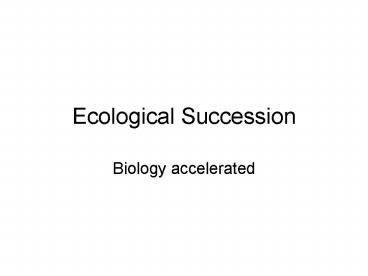Ecological Succession - PowerPoint PPT Presentation
1 / 33
Title:
Ecological Succession
Description:
As the crowns of pioneer species close, seedlings from these trees are unable to ... species, that often form thicker crowns than pioneers, new species that are ... – PowerPoint PPT presentation
Number of Views:2867
Avg rating:3.0/5.0
Title: Ecological Succession
1
Ecological Succession
- Biology accelerated
2
Homeostasis in Communities
- Ecosystems always changing
- Can be rapid- after a disturbance- flood, fire,
tornado, huricane. - Or slow- after volcano, bedrock, new land
- Why would the first group cause more rapid
succession? - There are always patterns which are followed.
3
Ecological Succession
-a series of predictable changes that occur in a
community over time
4
Primary succession
-occurs on surfaces where no soil exists
Ex. volcanic island forms in ocean
5
Secondary Succession
-occurs when a disturbance changes the existing
community
6
Ex. wildfires
7
Ex. Logging
8
Forest Succession The gradual replacement of
one community of plants by another, usually as a
result of differences in shade tolerance.
9
Pioneer species quickly occupy a site following
clearing. They grow rapidly to compete with
grasses and shrubs.
10
As the crowns of pioneer species close, seedlings
from these trees are unable to survive in the
resulting shade.
11
Different species that have a higher tolerance to
shade soon become established beneath the
pioneers.
12
As the short-lived pioneers near the end of their
life spans, the more tolerant trees in the forest
understory begin to take over the site. The
result is a major change in plant and animal
species.
13
Spruce begins to take over an aspen dominated
site in northern Minnesota as the short-lived
pioneer aspen crowns thin with aging.
14
Beneath the second successional stage species,
that often form thicker crowns than pioneers, new
species that are even more shade tolerant become
established.
15
The process of succession continues until the
most shade-tolerant species suitable for the site
(climax species) become established.
16
Seedlings of highly shade tolerant climax species
thrive in the shade of their parents. Because of
this, climax species will persist until
disturbance sets back the succession process to
the pioneer or some other stage.
17
Consider what happens following the harvest of
lodgepole pine in the western U.S.
18
Clearcutting in Lodgepole pine - Montana.
19
The clearcut site looks barren immediately
following harvest.
20
Similar area, two years following harvest,
showing that grass has covered the site. Young
pine seedlings are barely visible in the
foreground.
21
At ten years following harvest young lodgepole
pine trees, that have sprouted from seeds present
in the soil and spread by wind and wildlife, are
well established.
22
Compare this to developments following a clearcut
by nature.
23
In early summer 1988, as today, much of
Yellowstone park was covered by aging stands of
lodgepole pine. Many trees had been killed by
frequent outbreaks of the endemic Mountain Pine
Beetle.
24
This condition led to the Great Yellowstone fire,
1988
25
Vast areas of lodgepole pine and other forest
types were killed.
26
Eleven years later showed a landscape again
dominated by lodgepole pine that had sprouted
from seeds present in the soil.
27
Take a look at the commercial harvest of aspen in
Minnesota.
28
Clearcut harvesting in Minnesota aspen.
29
Aspen harvest site one year following clear-cut
harvest.
30
A good site several years following harvest.
50,000 to 100,000 stems per acre from stump
sprouting.
31
Question Assuming that 50,000 stems occupied
each acre of the harvested site several years
following stand establishment, what happened to
the other 49,800 trees?
Mature aspen stand. 65-70 years old.
Approximately 200 stems/acre.
32
When reproduction of species with medium to high
shade tolerance is desired following logging,
selective harvest methods can be used.
33
QuestionBased on what you have learned about
forest succession and the kinds of trees that are
most useful in producing structural timbers, why
would anyone who cares anything about forests
ever harvest by the clearcutting method?

